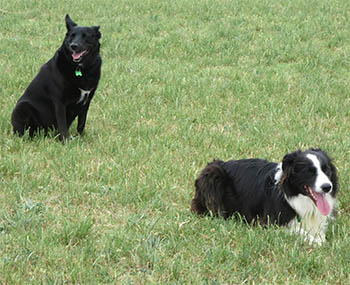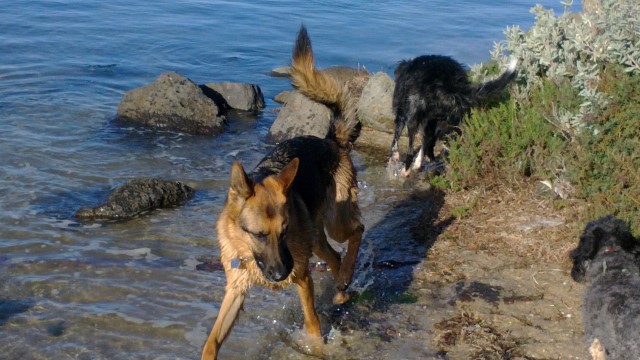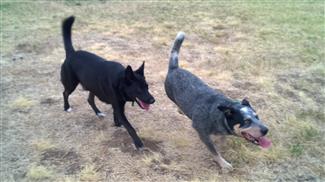Dog training – understanding communication by DOG SIGHT/ vision
 DOG training and communication Using SIGHT/ VISION
DOG training and communication Using SIGHT/ VISION
It is true that dogs rely most on scent to make their decisions, however from a distance scent can be very diluted and non directional, and it does not allow a dog to easily access the friendliness of another dog or human.
Like humans, dogs read body language from a distance to make decisions about what mood another dog or human are in. They listen to tone of words, and smell chemicals given off by a body, but the main method dogs access the emotional state of another creature is by sight.
Dogs learn from an early age to be great readers of body language, though when young, they often misread that body language (like humans) such as assuming that a wagging tail means friendly (when in fact it means excited, could be friendly or dangerous).
Dogs also have the ability to read human face emotions (unlike many other animals). Recent research papers have showed this amazing ability. This means that as a trainer, we need to be both very relaxed and in control of both our bodies, our faces and our tone of voice when issuing commands. There is nothing like a truth serum like a dog you are trying to train.
The specific mechanics of dogs vision.
Like humans dogs eyes are made up of rods and cones. Though the number and type of these varying meaning that a dogs vision, but comparison to a humans is:
- Dogs only see part of the colours in the visual spectrum The reds also appear as yellow. So everything is mostly blue and yellow to a dog.
- Dogs can generally see much further than humans but the resolution of that vision is less. This means that they can see you off in the distance but you may have to wave your arms about in recall if they can’t hear you.
- Dogs are very sensitive to seeing movement at distance, motion detection is considered good.
- Dogs have a Binocular field of vision of approx 40-60 degrees Dogs don’t have stereoscopic vision that means unlike humans, dog sight DOES NOT overlap – meaning they have limited depth of field to judge distance (using sight alone)
- Dogs see better in the dark than us as they have more rods.
VISUAL DOG TRAINING
So given all of the above information, you might begin to understand how a dogs visual perception is very different from ours. Reduced colour imaging, depth of field and resolution sometimes make small finger gestures difficult for dogs to understand over a distance – if they happen to be paying attention to your hands at all.
This is why large sweeping hand and arm gestures (see sheep dog trials) and loud audible commands are often given in sync with any visual dog training technique.
Also consider that a dog does never get hand signals from another dog, anything you are teaching a dog about dog training is given in human form that they then need to interpret. This is why lazy main training relies on repetition and food reward for a dog doing something that you want it to.
A dog learns better if a training is made into a game and is fun. Visually you can make it fun, but you have to use the same fun signals for life one established..
And it is always worthwhile to remember that the immediate environment and the early learning of all dogs from birth and anything anyone has taught them already that will have a large effect on any dogs decision making when it comes to training.
DOG TRAINING – DOGS FOR DIFFERENT PURPOSES, have different vision.
Just like dogs were bred for different ways to help owners (herding, working, hunting dogs etc) so are individual breeds blessed with different vision capabilities.
The most obvious high vision reliant dogs are SIGHT HOUNDS. These dogs are used by hunters to identify game, usually over long distances, then run the game down and hold/ kill them. This means that these dogs have better long distance vision, and slightly better resolution than the average dog. Their heads are typically long and narrow with eyes more directed at the front of the head. They have excellent movement detection, in relatively small resolution.
Other breeds of dogs have had changes to their vision accidently during cross breeding. because vision (except for hunting and perhaps herding) hasn’t been seen as the primary breeding thing for most dog breeds, the quality of a dog breeds vision has often been an accidental evolution.
While dogs rely mostly on smell to interpret the world, it is very hard for trainers to use this sense (unless you have a food reward that is very stinky) so sight and sound play a very large part of dog training.



